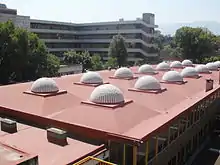School of Engineering, UNAM
The School of Engineering (Spanish: Facultad de Ingeniería) of the National Autonomous University of Mexico is the division of the aforementioned university in charge of engineering and applied studies in the physical and natural sciences.[1] At the undergraduate level, it offers thirteen majors and some graduate programs. In fall 2008, the school of engineering had over 10,900 undergraduate students and 1,115 graduate students and postdocs.[2] Chemistry and chemical engineering are offered neither by the School of Engineering nor the School of Sciences, but by a separate School of Chemistry.[3][4][5]
 Seal of UNAM's School of Engineering | |
| Type | Faculty |
|---|---|
| Established | 1910 |
| Dean | Carlos Agustín Escalante Sandoval |
| Students | 12,000 |
| Undergraduates | 10,900 |
| Postgraduates | 1,190 |
| Location | , |
| Colors | Blue & Gold (of the University) (of the faculty) |
| Website | www.ingenieria.unam.mx |
History
The school of Engineering at the UNAM has its origins as the Real Seminario de Mineria (Royal School of Mining), which building is still standing near the Zocalo in Mexico City. After the university was closed in 1833, several scientific institutes were established in Mexico, all of them related to some branch of engineering. These eventually merged into a single institution which in 1910 was put under the supervision of the newly created UNAM and renamed to Escuela Nacional de Ingeniería (National School of Engineering).
In 1954 the school changes its location to Ciudad Universitaria. In 1959, with the creation of the Engineering Institute and the availability of its first graduate program, the school changes its name to Facultad de Ingeniería.
Organization and departments

The school of engineering is organized in divisions (somewhat the equivalent of departments), each under the direct supervision of a Head of division. These are themselves coordinated and supervised by the faculty dean, currently Carlos Agustín Escalante Sandoval.
- Fundamental Science Division (DCB):
Is in charge of subjects such as physics and mathematics, every student has to take one or more subjects of this department, specially during the first 4 semesters. These subjects on fundamental science are then common to all students and are often regarded as the most difficult among all.
- Mechanical and Industrial Engineering Division (DIMEI):
In charge of the majors in the name, is the contact between the school and the industry, there are some programs for young entrepreneurial and some courses that may resemble a BA program in US
The civil Engineering division is one of the oldest divisions and has great prestige. Many famous researchers, and business leaders, such as Carlos Slim have studied in this division.
- Electrical Engineering Division (DIE): The Electric Engineering Division is in charge of three different bachelor's degrees: Electric Engineering, Computer Engineering and Telecommunication Engineering. It is the biggest division by number of students, as the degrees it offers have a high employment rate. This division, especially the computer engineering department, has established many on-going collaborations with industry and academia, such as: Google, Intel, IBM, Oracle, Telmex, Microsoft, Carnegie Mellon University, UC Berkeley, Stanford, and Wikimedia Foundation.[6][7][8][9] The DIE has a head chair that coordinates these different departments. The current chair is Dr. Boris Escalante. Each department also has its own chair and coordinator. The department with most students, faculty and infrastructure is the Computer Engineering department, whose current coordinator is professor Norma Elva Chavez.
- Earth Sciences Engineering (DICT):
This division is organizes the Mining, Petroleum, Geophysics and Geology Engineering bachelor Programs. Is one of the oldest divisions in the school and currently has some joint programs with PEMEX among other petroleum companies.
- Distance and Continuing Education Division:
As the name implies, this division is in charge of courses and diplomas for active professionals who wish to stay up to date with current technological trends or wish to stay in contact with the academic community in some way other than the conventional graduate programs.
- Social Sciences and Humanities Division (DCSyH):
In charge of cultural activities and some subjects, such as literature, ethics and history.
Graduate programs
Each division within the school of engineering organizes graduate programs. There are also graduate programs in cooperation with other graduate programs and other higher education institutions in Mexico.

Location and facilities
The school of engineering has numerous facilities, most of which are located in Ciudad Universitaria in Mexico City, between Faculty of Science and the Faculty of Administration.
It has two libraries for undergraduate students and one for graduate ones. It also has some of Mexico's finest laboratories for civil and mechanical engineering, and various laboratories of electronic engineering.
Noted alumni and faculty
- Carlos Slim, (Civil Engineer, Business man, and former world's wealthiest person.)
- Jesus Savage, (Professor in Computer Engineering, researcher, and founder of the Mexican Institute of Robotics)[10]
- Nabor Carrillo Flores (a soil mechanics expert, a nuclear energy advisor and former president of UNAM)
- Rodolfo Neri Vela, (Professor in Telecommunications Engineering and the first Mexican in space)
- Daniel Vargas, (Electrical Engineer and Volleyball Olympian)
- Jordi Messeguer Gally, (Industrial Engineer and PRD congressman)[11]
- Leda Speciale, (first Mexican woman to be a civil engineer, and currently an honorary professor in the school of engineering)[12]
- Enrique Martínez Romero, (Civil Engineer of the Torre Mayor, and Mexico City's international airport.[13])
- Leonardo Zeevaert, (Civil Engineer of the Torre Latinoamericana)
- Mariana Gonzalez, (Electrical Engineer, Entrepreneur, and co-founder of iluMexico, a Mexican social enterprise, that bring solar electricity to all Mexican homes[14])
- Julián Adem (Professor, researcher and civil engineer who developed important models to predict climate conditions.)
- Miguel Pedro Romo Organista (Civil Engineer, professor and researcher who innovated in building structures and materials to overcome earthquakes.)
- Juan Jacobo Shmittern (Doctorate in Civil Engineering)
- California Odha Zertuche Díaz, primary developer of the drinking water and sewerage system in Ensenada, Mexico.
Rankings
According to the QS Universities Rankings (2012)[15] the School of Engineering is positioned in the following rankings: Computer and Electrical Engineering: 51-100
Civil Engineering:51-100
Mechanical Engineering:151-200
Student organizations
The school of engineering has several student organizations, among them a Tuna, a chorus and a photo club.
Each major has its own student organization, which is in charge of promoting activities related to each specialization, such as extracurricular courses, workshops or congresses.
- SAFIR Sociedad Astronómica de la Facultad de Ingeniería (Astronomical Society of the Faculty of Engineering )[16]
Presidents of SAFIR
| Period | President | Career coursing |
|---|---|---|
| 1997-1999 | Alejandro Farah Simón (Founder)[17] | Mechanical Engineering |
| 1999-2000 | Penélope López | Mechanical Engineering |
| 2000-2002 | Francisco Tovar | Mechanical Engineering |
| 2002-2003 | Samanta Sabodka | Geophysical Engineering |
| 2003-2004 | Marisol Hernández Cuellar | Computer Engineering |
| 2004-2006 | Luis Efrén Flores | Electronical Engineering |
| 2006-2007 | Luis Vidal | Mechanical Engineering |
| 2007-2008 | Víctor Becerra Herrera | Civil Engineering |
| 2008-2009 | David Luna Martínez | Mechanical Engineering |
| 2009-2010 | Douglas Alberto Gómez Reyes | Geophysical Engineering |
| 2010-2011 | Mario Arturo Nieto Butrón | Computer Engineering |
| 2011-2012 | Agustín Romero | Mechanical Engineering |
| 2012-2013 | Diego Ulises Mendoza Arroyo | Telecommunications Engineering |
| 2013-2014 | Aldo Daniel Acosta Duran | Computer Engineering |
| 2014-2015 | Antonio Lledías | Mechanical Engineering |
| 2015–Present | Oscar Iván Calderón Hernández | Geophysical Engineering |
References
- "Universidad Nacional Autónoma de México (UNAM)".
- "Informe de actividades 2007". Informes Anuales (in Spanish). Facultad de Ingeniería–Universidad Nacional Autónoma de México. 7 May 2008. Archived from the original (PDF online document) on 28 May 2008. Retrieved 28 May 2008.
- UNAM, Facultad de Química. in Spanish. Retrieved 2 October 2016
- UNAM, Institute of Chemistry. . Retrieved 2 October 2016
- UNAM, Chemical Engineering - Bachelor's Degree. in Spanish. Retrieved 2 October 2016
- ""Hackatón" une a mujeres para crear casas inteligentes - Grupo Milenio".
- "Facultad de Ingeniería / Coordinación de Comunicación".
- "Facultad de Ingeniería / Coordinación de Comunicación".
- "Research:Guiding and Retaining Volunteers Using Social Media Bots - Meta".
- "Evoluciona la robótica en México". 24 August 2015.
- "Diario de Morelos | Contenido sobre Jordi Messeguer Gally | @diariodemorelos". Archived from the original on 18 September 2016. Retrieved 21 August 2016.
- "Ser ingeniera en los tiempos de Agustín Lara". 8 March 2015.
- "El hombre de la torre - construccion - obrasweb.com". www.obrasweb.mx. Archived from the original on 29 August 2016.
- http://www.iniciativamexico.org/perfiles/ilumexico/
- "QS World University Rankings by Subject 2022".
- Página de la sociedad Archived 1 September 2013 at the Wayback Machine SAFIR
- "¿Quién es? No.147 - Revista ¿Cómo ves? - Dirección General de Divulgación de la Ciencia de la UNAM".
External links
- Facultad de Ingeniería–UNAM, official website (in Spanish)
